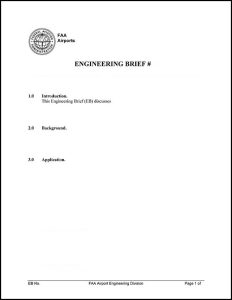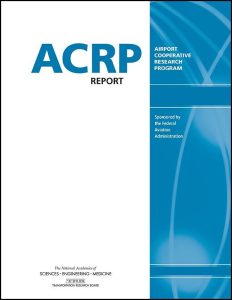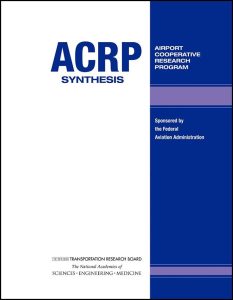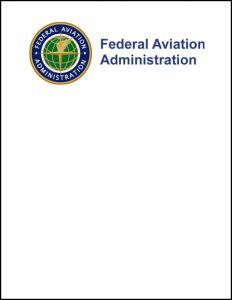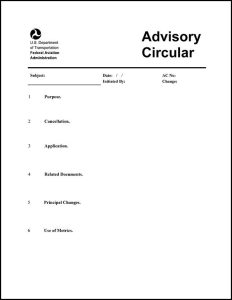To narrow the library of airside resources, use the filter boxes or airport map below or search box above.
Click an item below to expand.
Resources Matching Your Search
2013
Engineering Brief (EB) 91 provides new information and requirements for the management of vegetation on and/or surrounding an airport. This EB provides information on the removal or topping of vegetation as well as the collection, submission, and management of the supporting data regarding vegetation.
2013
ACRP Report 99 provides a step-by-step process for identifying, selecting, and implementing technologies to treat stormwater that has been affected by applied deicing materials. The report addresses the processes for identifying the various drivers for deicer treatment and for evaluating the appropriateness of various treatment technologies to meet an airport's specific needs. The report also provides recommendations for the design, operation, and maintenance of each treatment technology.
2020
ACRP Research Report 14, second edition, explores a wide array of practices designed to provide for the practical, cost-effective control of runoff from aircraft and airfield deicing and anti-icing operations. This second edition has been updated to reflect the latest industry practices. The report will be of particular interest to airport industry practitioners, including airport and aircraft operators, consultants, and regulators.
2017
ACRP Research Report 174 defines and discusses green stormwater infrastructure (GSI) management strategies, a relatively new approach to regulation compliance. As more airports are proactively incorporating sustainable practices in all aspects of their operations, federal and state regulatory agencies are promoting GSI strategies to comply with water regulations and requirements. Volume 1 is written for airport managers, planners, and engineers seeking to understand stormwater management and GSI compliance with regulatory standards and requirements, along with other benefits.
2017
ACRP Research Report 174 defines and discusses green stormwater infrastructure (GSI) management strategies, a relatively new approach to regulation compliance. As more airports are proactively incorporating sustainable practices in all aspects of their operations, federal and state regulatory agencies are promoting GSI strategies to comply with water regulations and requirements. Volume 2 assists airport staff with evaluating the applicability of a GSI strategy and selecting an appropriate GSI strategy.
2009
ACRP Synthesis 17 explores practices that airport sponsors and FAA planners and environmental specialists have used to integrate airport planning efforts and the FAA's environmental review processes.
2014
ACRP Synthesis 52 presents information on habitat management to deter wildlife at airports and manage risk to aviation. It is the third of three related syntheses and completes the series on wildlife risk management at airports. ACRP Synthesis 52 builds on previous ACRP documents, including ACRP Synthesis 23, ACRP Report 32, and ACRP Synthesis 39, which address bird deterrence and harassment techniques, various wildlife hazards and control techniques, and population management methods, respectively.
2020
This desk reference provides explanatory guidance for environmental impact analysis performed to comply with Council on Environmental Quality (CEQ) Regulations for Implementing the Procedural Provisions of the National Environmental Policy Act (CEQ Regulations) (40 Code of Federal Regulations (CFR) parts 1500-1508); U.S. Department of Transportation (DOT) Order 5610.1C, Procedures for Considering Environmental Impacts; and Federal Aviation Administration (FAA) Order 1050.1F Environmental Impacts: Policies and Procedures.
2013
ACRP Report 86 explores a protocol for evaluating and optimizing aircraft departure procedures in terms of noise exposure, emissions, and fuel burn. An accompanying CD-ROM contains a spreadsheet-based Departure Optimization Investigation Tool (DOIT) that allows users to understand and test tradeoffs among various impact measures, including noise levels, rate of fuel consumption, and emissions.
2016
ACRP Synthesis 69 explores drivers and outcomes of green initiatives undertaken at small commercial and general aviation airports. Drivers could include financial viability, staffing considerations, or other social or environmental factors.
2016
ACRP Synthesis 77 compiles information about airport sustainability practices and adds them to the Sustainable Aviation Guidance Alliance (SAGA) website. The SAGA website was developed to help airport operators develop sustainability programs and provide guidelines to those who have new data to input. The website contains entries on more than 900 sustainability practices that were developed by SAGA's initial stakeholder group.
2018
ACRP Synthesis 93 compiles information and examples that successfully demonstrate the value of building sustainability concepts into capacity-enhancing projects. The report describes additional resources and tools that provide information on how to select, apply, and communicate sustainability measures. The report explores how sustainability efforts often build on themselves, how lessons learned from one initiative are carried through to the next, and how this progressive learning process can enhance sustainability's role in capacity-enhancing projects over time.
2019
This advisory circular (AC) provides information on community/public involvement in airport planning. This AC is intended to advise airport sponsors, planners, and the public on the benefits of early public participation in airport planning, and the methods by which this participation may be achieved.
2015
This interactive site of Sustainable Aviation Guidance Alliance (SAGA) is useful to explore and share sustainability information. While geared toward airports, this site is useful for all industries to learn about sustainability, share ideas and experiences, search for practices based on custom information, and efficiently plan, implement and monitor sustainability activities.
2019
ACRP Report 16, second edition, is designed to help airport practitioners, owners, operators, managers, and policymakers of small airports, who may have varying degrees of experience and backgrounds, to fulfill their responsibilities in such areas as financial management, oversight of contracts and leases, safety and security, noise impacts, community relations, compliance with federal and state obligations, facility maintenance, and capital improvements. The first edition has been edited and reformatted for currency, relevance, and usability and updated with additional information and new subject areas (e.g., unmanned aircraft systems, geographic information systems, digital notices to airmen, social media, and federal and state obligations). Also, hyperlinks to many of the documents and resources mentioned in this report, such as ACRP publications, industry sources, and sample checklists, have been collected into ACRP WebResource 6: Resources for Managing Small Airports.
2017
ACRP Research Report 173 explores the potential environmental and health impacts of per- and polyfluoroalkyl substances (PFASs) typically found in aqueous film-forming foams (AFFFs). The report describes methods that can be used to identify areas of potential concern at an airport and ways to implement management and remediation practices. To help airports identify areas of potential environmental concern, the research team developed the Managing AFFF and PFASs at Airports (MAPA) Screening Tool.
2019
ACRP Research Report 208 provides guidelines on using benefit–cost analysis (BCA) to identify, evaluate, and select airport stormwater management projects. Many airports undertake stormwater projects to accommodate facility expansion, address obsolescence, and respond to evolving regulatory requirements. Often, stormwater infrastructure is installed or upgraded on a project-by-project and piecemeal basis, resulting in mismatches of sizes, material types, ages, and conditions. When airports are considering expanding or improving their stormwater facilities, the immediate need for stormwater infrastructure modification may not be clear, and a BCA is needed. The report will be particularly helpful for small airports that may not have BCA expertise or experience with innovative stormwater projects.
2007
This advisory circular (AC) provides guidance to airport sponsors that develop environmental management systems (EMS). It provides guidance to airport sponsors on the needed parts of an EMS.
2017
ACRP Research Report 166 provides a set of tools that operators of airports of varying sizes can use to understand, diagnose, and interpret airport water quality. This guidebook addresses water leaving the airport that does not go to an off-site treatment facility. Accompanying the report are tools to assist practitioners diagnose root causes and possible sources of specific problems that may require attention or mitigation: an editable Field Data Collection Form, a water quality data analysis tool, a customizable parameter fact sheet database, and an implementation presentation geared toward stakeholders.
2016
ACRP Research Report 169 describes the environmental regulations and permitting programs to which airports may be subject in their management of stormwater and other types of water resources. It covers governing federal programs; stormwater discharges associated with industrial activities, construction activities, and municipal separate storm sewer systems; process water or wastewater treatment discharges; industrial wastewater pretreatment discharges; and other relevant permit programs.
